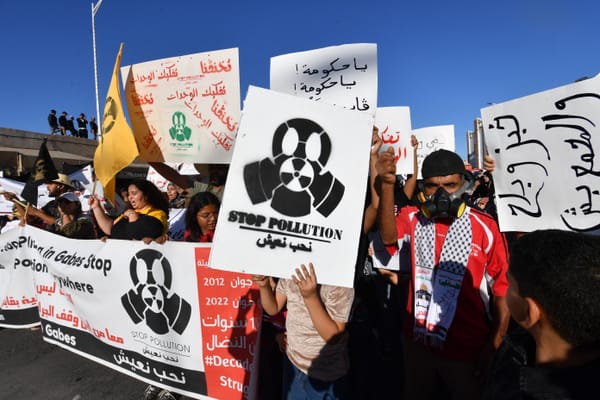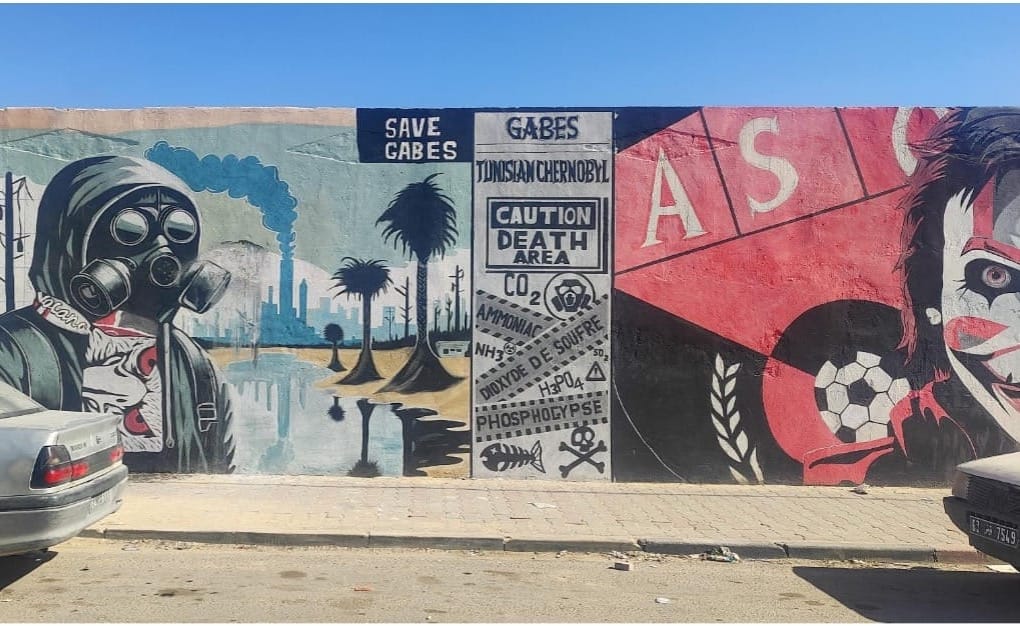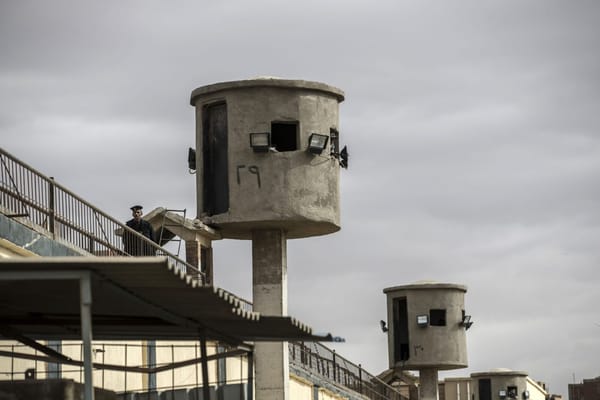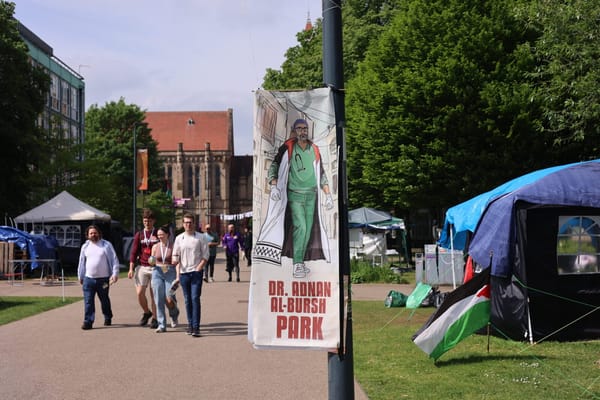'We Want to Breathe'—Dispatch from Gabes, Tunisia


A few weeks into the 2025 school year, in a middle school in Chott Essalem, Tunisia, students began to feel dizzy and light-headed and their throats tightened. Within minutes, they began collapsing, one after another. More mass asphyxiation events, as residents describe them, occurred throughout the month of September and into the early days of October. In total over 100 people, predominantly children, were affected. One mother, recalling the first incident to a local environmental group, described a harrowing scene of rows of children lying motionless on the ground, their stillness conjuring images she had seen of lifeless Palestinian children in Gaza.
When the students fell ill that September morning, few doubted the culprit. The Gabes governorate’s sprawling phosphate processing complex—run by Tunisian Chemical Group, more commonly known by its French designation Le Groupe Chimique Tunisien or simply Groupe Chimique—boasts a record of gas leaks that have caused similar episodes of poisonings over many years. Alongside severe ecological devastation, the toll most acutely felt by residents has been an alarming concentration in respiratory illnesses and rare cancers found nowhere else in Tunisia. They occur with such frequency that the governorate earned the apt—if grim—moniker of the nation’s “cancer capital.”
In conversations with Gabes residents, the refrain that all households contain at least one cancer patient is nearly universal. Compounding this public health catastrophe is a medical infrastructure that is both underfunded and ill-equipped to care for an ailing population. When the children of Chott Essalem fell unconscious, desperate parents called for ambulances only to be later turned away at the regional hospital.
People from Gabes will tell you that layering indignity upon injury is part and parcel of life in the shadows of the Groupe Chimique. Yet the rapid pace and scale of the Chott Essalem incidents this year were without precedent. Harrowing images and videos of fainting children spread like wildfire on social media and ignited public outrage.
On October 8, people in Gabes poured into the streets in protest following calls from local environmental groups, especially the local movement, Stop Pollution. Seasoned environmental activists and rambunctious football Ultras marched peacefully through Gabes city alongside children, mothers and Guwebsia (people from Gabes) from all walks of life. Central to their demands was the call to shut down the Groupe Chimique’s polluting units alongside the more aspirational, if seemingly unattainable, plea for clean air, as heard in the protest chant, “we want to breathe” (nhebou netnafssou).
The state’s answer came swiftly in yet another cloud of toxic gas, this time deployed by security forces to quell the mobilization.
The state’s answer came swiftly in yet another cloud of toxic gas, this time deployed by security forces to quell the mobilization. Meanwhile, during the evening news cycle, the national television broadcaster made no mention of the poisonings or the swelling public anger. It instead reported on Gabes’ bountiful pomegranate harvest this year. Protesters have since adopted the pomegranate as a symbol of their struggle, carrying the fruit alongside the classic Gabes quffa—a traditional handwoven basket made of palm leaves— while lampooning the silence of authorities and national media about the movement.
Undeterred, public protests have persisted with remarkable regularity since October 8. Local actions culminated in a general strike called by the Tunisian General Labor Union (UGTT) on October 21, which reported 100 percent participation. Stop Pollution estimated a historic turnout of 130,000 for the march that took place the same day, which would make it the largest collective mobilization in the governorate's history. On October 9, 18 and 26, hundreds of protesters also marched on the national headquarters of the Groupe Chimique in downtown Tunis. On October 26, members of the Tunisian diaspora organized a small solidarity rally in Paris’s Place de la République.
The movement’s sustained momentum and its percolation to the capital owes much to the supportive role of Tunis-based civil society associations, which have mobilized for Gabes and helped amplify news of the protests. The outpouring of support comes at a time of heightened repression of Tunisian civic activity under Law 88 that governs associations. In late October, the activities of prominent organizations and alternative media outlets—including the Tunisian Association for Democratic Women (ATFD), the Tunisian Forum for Economic and Social Rights (FTDES) and the media collective Inkyfada—were suspended for one month pending investigation.
In a commentary on the crisis earlier in October, President Kaïs Saied blamed what he called criminal policies inherited from past governments and promised an investigation into the poisoning episodes. Labeling the environmental and health conditions in Gabes as “environmental assassination,” his words echoed a speech he delivered in 2021 in which he similarly waxed poetic about the region’s threatened oases only months before seizing powers in what has been described as a constitutional coup. The context of that earlier speech was a trip by Saied to Gabes following an explosion within the industrial complex that claimed the lives of six workers. He pledged accountability, improved healthcare infrastructure and broader regional development.
Four years later, the unrelenting ferment in Gabes now poses perhaps the most serious challenge to Saied’s rule. Nothing short of shutting down the Groupe Chimique’s polluting units will suffice for many of the Guwebsia who have taken to the streets. Adding to the crisis, under Saied’s leadership the government intends to quintuple its production of phosphates from 2025 to 2030 to feed the nation’s depleted coffers.
Over 50 years ago, in October 1972, President Habib Bourguiba stood on the sandy beaches of Tunisia’s southern coastline and delivered a speech to the residents of Gabes governorate. The father of the modern Tunisian state and self-declared supreme leader in the battle against takhalof (backwardness, a bitter legacy of French colonial rule) inaugurated what he called one of the region’s “finest jewels.” Known for its storied oases and the singular coastal Mediterranean agroecology that sustained them, Gabes was the site of the new Maghrib Chemical Industries complex. Later renamed Groupe Chimique, the state-owned chemical company’s plant was the centerpiece of Tunisia’s industrial renaissance. It was built to transform raw phosphate into high-value fertilizers and chemical derivatives, propelling the country into an era of modernist development while leaving legacies of takhalof buried deep in its dust.
“Where yesterday there was only desert, steppe, and sand, where yesterday there was only ignorance, illiteracy, and resignation, today there is life,” proclaimed Bourguiba to an audience of Guwebsia eagerly awaiting development two decades into independence.[1] “This life is called water, irrigating the beautiful oases of Kebili and other oases in your governorate. This life is also the industry that has exploded here.” He celebrated the changing coastline of the region, noting its “smoking chimneys” and multiplying industrial ventures, including phosphoric acid plants, a brickworks factory, a power station, a gas pipeline and an industrial port. Tunisia’s most precious natural resource—phosphates—was extracted from the depths of Gafsa’s mines, refined in the embrace of Gabes’ oases and exported from its port. He concluded by predicting that, in the decades to come, the Gabes coastline would be beyond recognition.
Bourguiba’s prediction proved eerily accurate. Gabes did become unrecognizable, though not in the way he had promised...For decades, industrial activity in the region has discharged millions of tons of phosphogypsum waste along the coast of Gabes and released toxic fumes into the air.
Bourguiba’s prediction proved eerily accurate. Gabes did become unrecognizable, though not in the way he had promised. Indeed, it would bear little resemblance to the life of the oases stretching across the governorate—a point contemporary residents are quick to impress upon newcomers and one that marked my own initiation into the world of oasis life in 2022. For decades, industrial activity in the region has discharged millions of tons of phosphogypsum waste along the coast of Gabes and released toxic fumes into the air. Phosphogypsum is the hazardous by-product of phosphate fertilizer production that contains naturally-occurring radioactive material.
The complex’s day-to-day operations also use massive amounts of water that leave neighboring oases farmers in a chronic state of want. Older generations, now the nostalgic custodians of a pre-industrial oasis system once nourished by generous springs and fertile soil, recount stories and preserve faded photographs of an era when life was abundant. With the benefit of hindsight, young people, whose unemployment places the region third nationally, lament that an earlier generation was seduced by the vision of progress sold to them in the 1970s. Residents believe that they were left intentionally in the dark about the devastation the industry would unleash upon Gabes.
This article is made possible through the support of readers like you. Please consider a donation today
If Gabes is Tunisia’s “cancer capital,” it is also the beating heart of Tunisia’s environmental activism. The 2010–2011 uprising that toppled President Zine El Abidine Ben Ali and inspired other Arab uprisings opened unprecedented avenues for collective action. A diverse assemblage of social movements and civil society associations rallied behind the cause of defending Gabes’ fragile oasis ecology and stopping the Groupe Chimique’s pollution. From this wave of mobilization emerged Stop Pollution, alongside a host of other associations that wove environmental concerns into broader social and political agendas. Gabes now hosts what is arguably Tunisia’s only football Ultras culture that fuses environmental activism with club fandom.

In 2017, organizational efforts targeting the phosphate industry intensified as protesters descended on the industrial zone where the Groupe Chimique is located. The action coincided with broader mobilizations that swept across southern Tunisia, demanding a fair share of phosphate wealth for the country’s most deprived regions. These demonstrations also built upon the more spontaneous protests against the complex that occurred in the few weeks following Ben Ali’s fall. Since the uprising, disruptions have cost the state upward of $2 billion in lost production. Phosphate output has never returned to pre-2011 levels, and all extraction and processing sites remain designated as military zones.
Years of sustained struggle have yielded a handful of modest victories, namely limited compensation schemes for those officially recognized as affected, a 2017 decision to close the refinery’s most polluting units and the inclusion of phosphogypsum on the national list of hazardous materials. The latter two decisions, in particular, were greeted with celebration in a rare moment of vindication for Gabes.
But elation gave way to bewilderment and anger when both measures were quietly reversed earlier this year. This setback coincided with Tunisia’s launch of a national green hydrogen strategy that designates the Groupe Chimique as the pilot site for export-oriented green ammonia production. The mere announcement of this plan was enough to reignite protests in December 2024 and again in the spring of 2025, drawing old and young alike into the streets to resist what they saw as familiar forms of encroachment reinvented under an environmentally green guise. This fall, with children collapsing from toxic exposure at rates unseen in the region’s history, taking to the streets en masse felt almost instinctive for those whose struggles have long targeted the metaphorical and now literal asphyxia borne out of a development strategy blind to human wellbeing.
The foundation of today’s resistance to the new green ammonia plant and to industrial pollution writ large rests on the simple truth that the Groupe Chimique has taken far more from Gabes than it has ever given back. To quote Bourguiba one last time, he painted a picture of Gabes—with its “beautiful date palms and factory chimneys”—as a “landscape of contrasts” that embodied the “genius of the South.” Yet the true genius of Gabes is not in the forced and unsustainable coexistence of oasis and industry but in the stubborn capacity of its people for social mobilization against all odds and the ability to transform despair into organized opposition. For half a century, Guwebsia have borne witness to the slow unmaking of their environment, inhaling the costs of industrialization and exhaling resistance.
[Dhouha Djerbi is a doctoral candidate in international relations and political science at the Geneva Graduate Institute, Switzerland.]
[1] All Habib Bourguiba quotes are from “L’industrialisation se poursuit,” October 6, 1972, in Habib Bourguiba, Discours, Tomme 21 (1970-1972), pp. 308–312. (Tunis: Publications du Ministère de l’Information).








